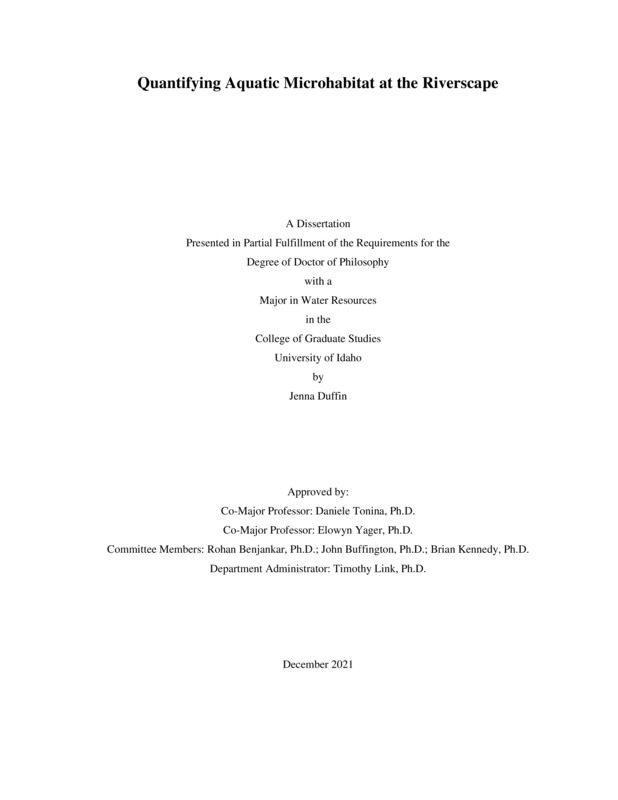Quantifying Aquatic Microhabitat at the Riverscape
Duffin, Jenna. (2021-12). Quantifying Aquatic Microhabitat at the Riverscape. Theses and Dissertations Collection, University of Idaho Library Digital Collections. https://www.lib.uidaho.edu/digital/etd/items/duffin_idaho_0089e_12231.html
- Title:
- Quantifying Aquatic Microhabitat at the Riverscape
- Author:
- Duffin, Jenna
- ORCID:
- 0000-0002-0429-817X
- Date:
- 2021-12
- Keywords:
- Aquatic habitat ecohydraulics habitat modeling riverscape topobathymetric LiDAR
- Program:
- Water Resources
- Subject Category:
- Geomorphology; Aquatic sciences
- Abstract:
-
Analyzing morphologic, hydrologic, and biologic conditions that impact aquatic habitat conditions is vital for river management. With increasing anthropogenic pressures on natural systems, it has become more important to quantify the impacts of alterations to topography, water supply and biological characteristics such as temperature on riverine ecosystems. While most studies focus on reach-scale analyses of morphologic and habitat conditions, in this work we leverage high-resolution topobathymetric data to perform analyses along the entire length of rivers. This dissertation focuses on large-scale analysis of the morphology and aquatic habitat available in rivers with varying levels of human alterations. In the first research chapter, we used continuous wavelet analysis to identify scales of topographic variability present along three rivers. We found three wavelet scales of topographic variability: a small scale, representing the pools and riffles along the rivers; a mid-wavelet scale, detecting larger pools/bars and compound pools; and a large wavelet scale, linked to changes in reach morphology from valley-scale controls. Using the small wavelet scale, we developed a novel methodology to identify pools and riffles along entire lengths of rivers. We also found that redds (salmon nests) were not randomly located, but rather placed in areas of higher, small-scale, wavelet power showing the importance of well-developed pool-riffle morphology for spawning habitat selection. The second research chapter focuses on the effects of flow regulation on topography and physical habitat in two morphologically distinct reaches. We developed reach-scale morphodynamic models to address the impacts of regulated and unregulated flows on the morphology and resulting rearing and spawning habitat for salmonids. Our findings show that years of regulated flows have created subdued topography in the river, while unregulated flows can increase the frequency, area, depth, and volume of pools and bars in the meandering reaches of the river, but not in the highly-altered straightened reaches. Although changes to the topography between regulated and unregulated flows did not greatly affect the modeled habitat suitability for salmonids, the increase in pool characteristics greatly increased overwintering habitat for juvenile salmonids. In the final chapter, we use a bioenergetics model to quantify the juvenile salmonid carrying capacity along the entire length of a river. By varying the inputs of food availability, stream temperature, and juvenile fish size, we can address how juvenile carrying capacity varies throughout the river and the potential to increase or reduce carrying capacity. We found that increasing food and decreasing stream temperature generally increased the juvenile carrying capacity of the river, but the territorial nature of juvenile salmonids and the local hydraulics modulated how temperature, food and fish size affected carrying capacity. We also found that redd site selection was dependent, not only on spawning habitat quality, but also on the presence of good juvenile habitat. These analyses efficiently provide information on existing morphology in rivers and potential changes to the morphology and aquatic habitat through hydrologic, topographic, and biological alterations. The analyses are completed using high-resolution topographic data and modeling, providing information at a scale relevant to a fish, but are completed, or can be extrapolated, to entire lengths of rivers, which provides an important riverscape view for managers.
- Description:
- doctoral, Ph.D., Water Resources -- University of Idaho - College of Graduate Studies, 2021-12
- Major Professor:
- Yager, Elowyn M; Tonina, Daniele
- Committee:
- Benjankar, Rohan M; Buffington, John M; Kennedy, Brian P; Link, Timothy E
- Defense Date:
- 2021-12
- Identifier:
- Duffin_idaho_0089E_12231
- Type:
- Text
- Format Original:
- Format:
- application/pdf
- Rights:
- In Copyright - Educational Use Permitted. For more information, please contact University of Idaho Library Special Collections and Archives Department at libspec@uidaho.edu.
- Standardized Rights:
- http://rightsstatements.org/vocab/InC-EDU/1.0/

